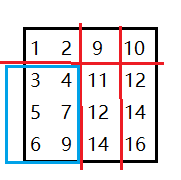1.二维数组中的查找
在一个二维数组中,每一行都按照从左到右递增的顺序排序,每一列都按照从上到下递增的顺序排序。请完成一个函数,输入这样的一个二维数组和一个整数,判断数组中是否含有该整数。

public class Solution {
public boolean Find(int target, int [][] array) {
if(array == null||array.length==0) return false;
int rowIdx = 0,colIdx = array[0].length-1;
while(rowIdx<array.length&&colIdx>=0){
if(array[rowIdx][colIdx] == target)
return true;
else if(target>array[rowIdx][colIdx])
rowIdx++;
else if(target<array[rowIdx][colIdx])
colIdx--;
}
return false;
}
}
2.替换空格
请实现一个函数,将一个字符串中的空格替换成“%20”。例如,当字符串为We Are Happy.则经过替换之后的字符串为We%20Are%20Happy。
public class Solution { public String replaceSpace(StringBuffer str) { StringBuilder sb = new StringBuilder(); for(int i = 0;i<str.length();i++){ if(str.charAt(i)==' '){ sb.append("%20"); } else sb.append(str.charAt(i)); } return sb.toString(); } }
3.从尾到头打印链表
输入一个链表,从尾到头打印链表每个节点的值。
/**
* public class ListNode {
* int val;
* ListNode next = null;
*
* ListNode(int val) {
* this.val = val;
* }
* }
*
*/
import java.util.ArrayList;
import java.util.Stack;
public class Solution {
public ArrayList<Integer> printListFromTailToHead(ListNode listNode) {
ArrayList<Integer> result = new ArrayList<>();
Stack<Integer> stack = new Stack<>();
if(listNode == null) return result;
while(listNode != null){
stack.push(listNode.val);
listNode = listNode.next;
}
while(!stack.isEmpty())
result.add(stack.pop());
return result;
}
}
4.重建二叉树
使用递归
输入某二叉树的前序遍历和中序遍历的结果,请重建出该二叉树。假设输入的前序遍历和中序遍历的结果中都不含重复的数字。例如输入前序遍历序列{1,2,4,7,3,5,6,8}和中序遍历序列{4,7,2,1,5,3,8,6},则重建二叉树并返回。
/**
* Definition for binary tree
* public class TreeNode {
* int val;
* TreeNode left;
* TreeNode right;
* TreeNode(int x) { val = x; }
* }
*/
public class Solution {
public TreeNode reConstructBinaryTree(int[] pre, int[] in) {
if (pre == null || in == null || pre.length != in.length) return null;
return reConstructBinaryTreeCore(pre, 0, pre.length - 1, in, 0, in.length - 1);
}
public TreeNode reConstructBinaryTreeCore(int[] pre, int preStartIdx, int preEndIdx, int[] in, int inStartIdx, int inEndIdx) {
TreeNode node = new TreeNode(pre[preStartIdx]);
if (preStartIdx == preEndIdx)
if (inStartIdx != inEndIdx || pre[preStartIdx] != in[inStartIdx])
System.out.println("Invalid input.");
int i = 0;
while (pre[preStartIdx] != in[inStartIdx + i])
i++;
if (i == 0)//证明没有左子树
node.left = null;
else
node.left = reConstructBinaryTreeCore(pre, preStartIdx + 1, preStartIdx + i, in, inStartIdx, inStartIdx + i - 1);
if (inStartIdx + i == inEndIdx)//证明没有右子树
node.right = null;
else
node.right = reConstructBinaryTreeCore(pre, preStartIdx + i + 1, preEndIdx, in, inStartIdx + i + 1, inEndIdx);
return node;
}
}
5.用两个栈实现队列
用两个栈来实现一个队列,完成队列的Push和Pop操作。 队列中的元素为int类型。
import java.util.Stack;
public class Solution {
Stack<Integer> stack1 = new Stack<Integer>();
Stack<Integer> stack2 = new Stack<Integer>();
public void push(int node) {
stack1.push(node);
}
public int pop() throws Exception {
if(stack1.isEmpty()&&stack2.isEmpty())
throw new Exception("Queue is empty.");
if(!stack2.isEmpty())
return stack2.pop();
while(!stack1.isEmpty())
stack2.push(stack1.pop());
return stack2.pop();
}
}
6.旋转数组的最小数字
把一个数组最开始的若干个元素搬到数组的末尾,我们称之为数组的旋转。 输入一个非递减排序的数组的一个旋转,输出旋转数组的最小元素。 例如数组{3,4,5,1,2}为{1,2,3,4,5}的一个旋转,该数组的最小值为1。 NOTE:给出的所有元素都大于0,若数组大小为0,请返回0。
public class Solution {
public int minNumberInRotateArray(int [] array) {
if(array == null||array.length == 0)return 0;
int idx1 = 0,idx2 = array.length-1;
//如果不能进入while循环,则证明第一个元素小于最后一个元素,而且数组为非递减排序,最小值即为首位。
while(array[idx1]>=array[idx2]){
//第一个指针指向前半段递增序列的末尾,第二个指针指向后半段递增序列的首位。
if(idx2-idx1==1)return array[idx2];
//二分法查找临界点
int mid = (idx1+idx2)/2;
//考虑特例:{1,0,1,1,1}
if(array[idx1] == array[idx2]&& array[mid] == array[idx1]){
for(int i = idx1;i<=idx2;i++)
if(array[i]<array[mid])
return array[i];
//特例:{1,1,1,1,1,1,1}
return array[mid];
}
//更新指针,直至idx2-idx1==1;
if(array[mid]>=array[idx1])
idx1 = mid;
else if(array[mid]<=array[idx2])
idx2 = mid;
}
//此时数组为递增排列,第一个元素最小
return array[0];
}
}
7.斐波那契数列(这个数列从第3项开始,每一项都等于前两项之和)
大家都知道斐波那契数列,现在要求输入一个整数n,请你输出斐波那契数列的第n项。
n<=39
public class Solution {
public int Fibonacci(int n) {
if(n<1) return 0;
int[] fibonacci = new int[2];
fibonacci[0] = 1;
fibonacci[1] = 1;
n-=2;
while(n>0){
int temp = fibonacci[0]+fibonacci[1];
fibonacci[0] = fibonacci[1];
fibonacci[1] = temp;
n--;
}
return fibonacci[1];
}
}
8.跳台阶(动态规划)
一只青蛙一次可以跳上1级台阶,也可以跳上2级。求该青蛙跳上一个n级的台阶总共有多少种跳法。
public class Solution {
public int JumpFloor(int target) {
if(target < 1) return 0;
int[] DP = new int[3];
DP[0] = 1;
DP[1] = 2;
DP[2] = DP[0]+DP[1];
if(target<=3)
return DP[target-1];
for(int i =4;i<=target;i++){
DP[0] = DP[1];
DP[1] = DP[2];
DP[2] = DP[0]+DP[1];
}
return DP[2];
}
}
9.矩形覆盖
我们可以用21的小矩形横着或者竖着去覆盖更大的矩形。请问用n个21的小矩形无重叠地覆盖一个2*n的大矩形,总共有多少种方法?
public class Solution { public int RectCover(int target) { if(target<1) return 0; int[] DP = new int[3]; DP[0] = 1; DP[1] = 2; DP[2] = DP[1]+DP[0]; if(target<4) return DP[target-1]; for(int i = 4;i<=target;i++){ int temp = DP[1]+DP[2]; DP[0] = DP[1]; DP[1] = DP[2]; DP[2] = temp; } return DP[2]; } }
10.二进制中1的个数
输入一个整数,输出该数二进制表示中1的个数。其中负数用补码表示。
public class Solution { public int NumberOf1(int n) { int count = 0; while(n!=0){ count+=n&1; n=n>>>1; } return count; } }



